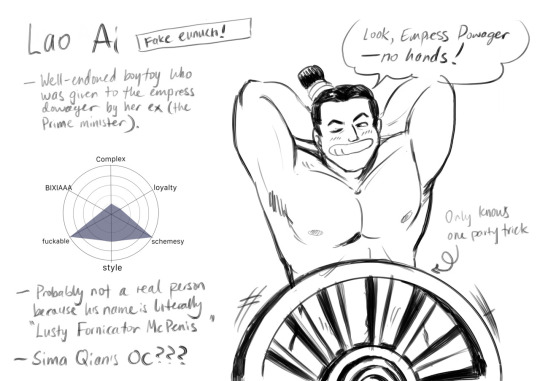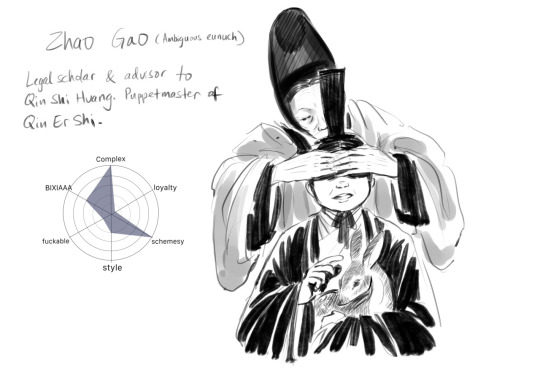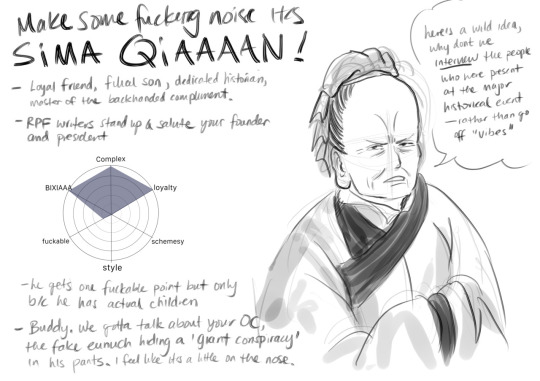#History of AI
Explore tagged Tumblr posts
Text
From Turing's groundbreaking test in the 1950s to the jaw-dropping capabilities of GPT-3 in 2020, AI has evolved at a mind-bending pace. Dive into a thrilling journey through time, uncovering AI's most iconic moments. Ever wondered how Siri or Alexa came to be? Or what sparked the first AI winter? Discover the secrets of AI's past and get a glimpse of its future. 🔍🤖 #AITimelineRevealed
12 notes
·
View notes
Text

"Dyke March 1994" by Morgan Gwenwald
source: The Wild Good: Lesbian Photographs & Writings on Love, edited by Beatrix Gates
#lesbian#lesbian literature#dyke#dyke literature#archived#thatbutcharchivist#dyke march#dyke march 1994#lesbian history#lesbian photography#author: beatrix gates#photographer: morgan gwenwald#the wild good#year: 1996#publisher: anchor books#publisher: doubleday dell publishing group inc.#butch#butch dyke#butch lesbian#why does it look alright while i'm editing and then hitting the finished button is like unleashing an entirely different monster#ai yai yai#i'll figure it out#asian lesbian
26K notes
·
View notes
Text
History of AI?

If you do not know what AI is then read this -What is AI (Artificial Intelligence)? Will it be able to replace humans?
1950 Turing Test: If we talk about history, the first test on AI was conducted in 1950. Through Alan Turing, it was tested whether the machine could actually think or not, and this test passed. In this test it was found that machines can think just like us humans. This test came to be known as Turing Test.
1955 AI Born: 1955 was an era when artificial intelligence was named. This name was given to AI by American computer scientist John McCarthy.
1961 Robot: The first industrial robot was put into use in 1961. This robot was first used in the General Motors assembly line in 1961.
1961 First Chatbot: The first chatbot was introduced in this year. Which was introduced by Joseph Weizenbaum in 1961 and was known as ELIZA.
1997 Deep Blue: Deep Blue computer or system was created in 1997 by IBM. Which was specially created for chess playing. And this system or computer defeated world champion Garry Kasparov.
1999 AIBO: In 1999, Sony launched its consumer robot dog known as AIBO. This AIBO was a robotic dog, which revolutionized AI.
2011 Siri: In 2011, Apple launched its virtual assistant which became known as Siri.
2014 Alexa: Due to this AI revolution, Amazon launched its voice assistant, which came to be known as Alexa.
2017 AlphaGo: AlphaGo is a computer program created by Google's acquired subsidiary DeepMind. This program was created specifically for Go game, when this program defeated the world champion Ke Jie in Go game in 2017, even after this success, there was a difference in the trend of AI because this program is completely based on machine learning and Was working on Deep Learning.
30 November 2022: On 30 November 2022, a new revolution came in AI. Known as ChatGPT, it is an AI chatbot which was launched by OpenAI. The biggest revolution in the history of AI has come because of ChatGPT. Ever since ChatGPT was launched, AI has reached new heights, and you can see that height today.
1 note
·
View note
Text
Seeing generative AI in queer spaces is chilling for a lot of reasons. Not least among them being that it's an easy way to edge out queer creators who are already in a precarious position, facing book bans and attacks from all sides.
As a queer history resource, watching an AI try and fill the roll that has taken so long to carve out for actual people, is disheartening. It's great to know that there is demand for queer history resources, but after so many queer people have worked so hard to build a space for themselves, it feels disrespectful to watch that spot be filled by machines.
Queer people have won the battle in a way, convinced the world that our stories are worthwhile. I suppose it shouldn't be shocking to see that the response is to try and find a way to not compensate queer people for any of their work and value.
#queer history#seeing AI write queer history articles is... not fun#especially while this project struggles in the face of rising costs of living
4K notes
·
View notes
Text










[Update: Apocalypse in Pink part 2 is out now]
Before Barbenheimer, there was “Apocalypse in Pink,” the August 1983 theme of fashion/culture magazine SPECTAGORIA. The issue’s controversial imagery of Barbie-esque models attempting to stay gorgeous and glamorous amidst nuclear annihilation sought to, in the words of editor/photographer Sera Clairmont, “revel in the morbid absurdity of the new American condition,” an “anxiety vibrating underneath all our plastic smiles.”
“It’s The Hot Pink Cold War,” Clairmont wrote in her introduction. “It’s ‘Material Girl’ on the radio and ‘WarGames’ at the drive-in. It’s ‘Girls Just Wanna Have Fun’ interrupted by the emergency broadcast signal. We’re told to look sexy, dress fashionable, make money, and spend money, but be sure we’re just the right amount of terrified about the bomb. Get that Malibu dream home, keep working on that perfect body, sip cocktails by the pool in your little pink bikini and watching the stocks go up — but STAY VIGILANT! and for God’s sake vote Republican, because that dream home could melt into a pink plastic inferno at any given moment. Just don’t stop smiling as the blast liquefies your skin into bubbling ooze like a Barbie doll in a microwave - it’s bad for the economy.”
***Continued in PART 2***
---------
NOTE: This is a work of fiction created by me. This alternate reality horror story is part of my NightmAIres narrative art series (visit that link for a lot more). NightmAIres are windows into other worlds and interconnected alternate histories, conceived/written by me and visualized with synthography and Photoshop.
If you enjoy my work, consider supporting me on Patreon for frequent exclusive hi-res wallpaper packs, behind-the-scenes features, downloads, events, contests, and an awesome fan community. Direct fan support is what keeps me going as an independent creator, and it means the world to me.
#rob sheridan#barbie#barbie movie#barbenheimer#synthography#nightmAIres#ai horror#ai art#synthography horror#alternate history#writing#spectagoria#sera clairmont#horror fashion#ai fashion
23K notes
·
View notes
Text
Where are we headed in terms of artificial intelligence?
What do we know about Artificial Intelligence (AI)? Where are we and where are we heading?

View On WordPress
0 notes
Text
Know about Artificial Intelligence(AI)....
The content provides a comprehensive overview of artificial intelligence (AI), its origins, types, and applications. It also discusses the differences between deep learning and machine learning, as well as the rise of generative models in AI. The history
artificial intelligence Artificial intelligence (AI) is a fascinating field that combines computer science and robust datasets to enable problem-solving and decision-making capabilities similar to those of the human mind. It leverages computers and machines to mimic human intelligence and understand complex patterns in data. AI encompasses several sub-fields, such as machine learning and deep…

View On WordPress
1 note
·
View note
Text


The Unclean
#halloween#artist#painting#art#artblr#oil on canvas#oil painting#dark art#horror#goth#gothic#gothcore#art community#artists#ai generated#the nun#witch#dark fantasy#religious imagery#religious painting#religious art#art history#art gallery#witchcore#witchcraft#witches
3K notes
·
View notes
Text
Unlocking the Power of Artificial Intelligence (AI): A Comprehensive Guide to Types, Applications, and Future Prospects Of AI

Introduction
Artificial Intelligence (AI) is a rapidly evolving field that has gained significant attention and interest in recent years. This article aims to provide you with a comprehensive guide to AI, covering its definition, history, types, applications, benefits, challenges, ethical considerations, and future prospects.
What is Artificial Intelligence?
Artificial Intelligence refers to the development of computer systems that can perform tasks that typically require human intelligence. It involves simulating human intelligence and learning from data to make predictions, solve problems, and automate processes.
The History of AI
AI traces its roots back to the 1950s when researchers began exploring the possibility of creating intelligent machines. Over the decades, significant advancements have been made in AI technologies, including the development of expert systems, machine learning algorithms, and deep neural networks. Read more
1 note
·
View note
Text
Our Daily Life in Gaza 💔
We search for water, firewood, food, electricity, we spend our day searching for the basics of life and trying to survive !! 😔
I'm talking to the human in your heart,, Please, Help Save My Family To Survive 🙏💔
Vetted By @90-ghost , @riding-with-the-wild-hunt ✅
Every Donation, No Matter How Small, it Really Helps 😭
If you think we are joking about our lives, look away, but don't forget that we are human..🥀
#free gaza#free palestine#gaza strip#human rights#humanity#artists on tumblr#save gaza#gaza#save palestine#i stand with palestine#all eyes on palestine#free rafah#all eyes on rafah#rafah#mutual aid#palestine aid#humanitarian aid#ai digital art#adult human female#deadpool and wolverine#save us#politics#us politics#kamala harris#vote kamala#october#september#history#world#people
1K notes
·
View notes
Text

Most people don't realize how long we have been using Artificial Intelligence.
6 notes
·
View notes
Text
"In the 1750s, an Italian farmer digging a well stumbled upon a lavish villa in the ruins of Herculaneum. Inside was a sprawling library with hundreds of scrolls, untouched since Mount Vesuvius’ eruption in 79 C.E. Some of them were still neatly tucked away on the shelves.
This staggering discovery was the only complete library from antiquity ever found. But when 18th-century scholars tried to unroll the charred papyrus, the scrolls crumbled to pieces. They became resigned to the fact that the text hidden inside wouldn’t be revealed during their lifetimes.
In recent years, however, researchers realized that they were living in the generation that would finally solve the puzzle. Using artificial intelligence, they’ve developed methods to peer inside the Herculaneum scrolls without damaging them, revealing short passages of ancient text.
This month, researchers announced a new breakthrough. While analyzing a scroll known as PHerc. 172, they determined its title: On Vices. Based on other works, they think the full title is On Vices and Their Opposite Virtues and in Whom They Are and About What.
“We are thrilled to share that the written title of this scroll has been recovered from deep inside its carbonized folds of papyrus,” the Vesuvius Challenge, which is leading efforts to decipher the scrolls, says in a statement. “This is the first time the title of a still-rolled Herculaneum scroll has ever been recovered noninvasively.”
On Vices was written by Philodemus, a Greek philosopher who lived in Herculaneum more than a century before Vesuvius’ eruption. Born around 110 B.C.E., Philodemus studied at a school in Athens founded several centuries earlier by the influential philosopher Epicurus, who believed in achieving happiness by pursuing certain specific forms of pleasure.
“This will be a great opportunity to learn more about Philodemus’ ethical views and to get a better view of the On Vices as a whole,” Michael McOsker, a papyrologist at University College London who is working with the Vesuvius Challenge, tells CNN’s Catherine Nicholls.
When it launched in 2023, the Vesuvius Challenge offered more than $1 million in prize money to citizen scientists around the world who could use A.I. to help decipher scans of the Herculaneum scrolls.
Spearheaded by Brent Seales, a computer scientist at the University of Kentucky, the team scanned several of the scrolls and uploaded the data for anyone to use. To earn the prize money, participants competed to be the first to reach a series of milestones.
Reading the papyrus involves solving several difficult problems. After the rolled-up scrolls are scanned, their many layers need to be separated out and flattened into two-dimensional segments. At that point, the carbon-based ink usually isn’t visible in the scans, so machine-learning models are necessary to identify the inked sections.
In late 2023, a computer science student revealed the first word on an unopened scroll: “porphyras,” an ancient Greek term for “purple.” Months later, participants worked out 2,000 characters of text, which discussed pleasures such as music and food.
But PHerc. 172 is different from these earlier scrolls. When researchers scanned it last summer, they realized that some of the ink was visible in the images. They aren’t sure why this scroll is so much more legible, though they hypothesize it’s because the ink contains a denser contaminant such as lead, according to the University of Oxford’s Bodleian Libraries, which houses the scroll.
In early May, the Vesuvius Challenge announced that contestants Marcel Roth and Micha Nowak, computer scientists at Germany’s University of Würzburg, would receive $60,000 for deciphering the title. Sean Johnson, a researcher with the Vesuvius Challenge, had independently identified the title around the same time.
Researchers are anticipating many more breakthroughs on the horizon. In the past three months alone, they’ve already scanned dozens of new scrolls.
“The pace is ramping up very quickly,” McOsker tells the Guardian’s Ian Sample. “All of the technological progress that’s been made on this has been in the last three to five years—and on the timescales of classicists, that’s unbelievable.”"
-via Smithsonian, May 16, 2025
#I've been following this project for a couple of years now it's honestly super exciting#we are going to read scrolls that were charred shut in antiquity!!! that people thought could never be read#because they could never be unrolled#no one was read these words in 2000 years!!!!#until now!!!!!#archeology#ai#herculaneum#pompeii#vesuvius#citizen science#classics#classical studies#classical literature#ancient rome#artificial intelligence#roman history#ancient history#philosophy#epicurus#epicurean#good news#hope
597 notes
·
View notes
Text

Happy Year of the Snake! on venom and vigilance - 2025
#air dry clay#creature#ellen jewett#handmade#maximalism#mixed media#natural history#not ai art#ooak#polymer clay#snake#wabisabi#artists on tumblr#clay art#artwork#art#pop surrealism#sculpture#serpent#clay#botanical art#pop surreal art
458 notes
·
View notes
Text
Is it me or is history is repeating itself?

#history repeats itself#dashcon#funny#willy wonka experience#satire#meme#the office#same energy#and the fact in the WW experience they used AI art for their advertisement.. WOW! that’s scummy#tumblr 2014#Willy Wonka#you had one job#Shitpost#they really fucked up#scam#bruh#pam halpert#pam beesly#gladclow Wonka experience#tumblr chaos#chaos#charlie and the chocolate factory#Wonka#spilling the tea#viral
2K notes
·
View notes
Text
i love the hilarious eunuch ranking system by @welcometothejianghu so i decided to make one based on (mostly) REAL historical chinese enunchs!
in chronological order:

Warring States Period long story short, the PM is sleeping with the Empress Dowager, and he wants to extracate himself before her son (future Emperor Qin Shi Huang) gets old enough to find out. the PM finds her a suitable replacement, and the replacement is attached to a guy named Lao Ai. They pluck his beard and pass him off as a eunuch so he can sneak into the palace. Bing bang boom everyone's happy. This goes terribly wrong later, since Lao Ai tries to replace the emperor with his own kids and stages a failed coup. rest in pieces buddy...
it's very likely that Lao Ai was a ficticious character invented by Sima Qian, who will be appearing on this list later.

Qin Dynasty
Zhao Gao helped the first emperor of China conquer an empire, and administer it efficiently with his legal knowledge, but he also made the second emperor into a puppet, and weakened the empire for his own political gain. Max points of complexity, but you'd get more loyalty out of a coffee club punch card.
Before launching his soft coup, he decided to test the waters by bring in a deer and gaslighted the emperor by calling it a horse. the officials who were loyal to him called it a horse, and he executed the rest.

Han Dynasty Jiru, male favourite of Emperor Gaozu (Liu Bang), the peasant scoundrel who became the founder of the Han Dynasty. look, if the emperor has a harem of hundreds of women and you manage to catch his attention, you max out in style points. simple as. for most of chinese history it was fairly common for high-ranking men, especially eunuchs, to wear make up like powder and rouge, but i decided to give Jiru some women's huadia as well, cause he's a baddie.
Jiru gets a bad rap for alledgely distracting the emperor from his duties, but lets be real, history is written by civil officials who have no shortage of professional jealousy and gender/sexuality related prejudice towards eunuchs, since they were the personal attendants of royalty and could exert a lot of influence. plus Liu Bang was already pissing in the hats of confucian scholars, most of the poor work ethic is on HIM. Jiru should get credit for making him marginally less of a troglodite.
all in all he didn't try any court intrigue so extra points for loyalty and complexity. free my man >:( he's just a Han dynasty Monica Lewinsky who got slutshamed by jealous coworkers >:(

Han Dynasty
meet the father of east asian history, sima qian. half the people on this list can owe their placement here thanks to his extremely though history books "records of the grand historian"
history at this time was mostly "creative writing" and sima qian attempted to give the practise more academic intergrety, he went out and personally interviewed people, tried to get primary sources, and got rid of most of the more fanstastical aspects. however, he was not without his biases and some texts can be seen as allegorical/veiled insults towards the Han Dynasty, especially towards Emperor Wu. unlike most of the people on this list, sima qian was from the gentry and castated later in life as a punishment for treason. he was implicated after trying to defend a friend, and could not pay the fine to commute his sentence. the gentlemen at the time were expected to die by suicide rather than live with such ignimony, but sima qian chose to live so he could finish writing the history book his father started. the "giant conspiracy" joke explained: the chinese word for penis is a homophone for "conspiracy".
836 notes
·
View notes
Text

Frank Rosenblatt, often cited as the Father of Machine Learning, photographed in 1960 alongside his most-notable invention: the Mark I Perceptron machine — a hardware implementation for the perceptron algorithm, the earliest example of an artificial neural network, est. 1943.
#frank rosenblatt#tech history#machine learning#neural network#artificial intelligence#AI#perceptron#60s#black and white#monochrome#technology#u
820 notes
·
View notes